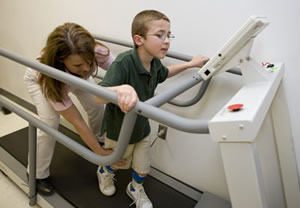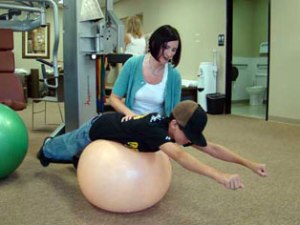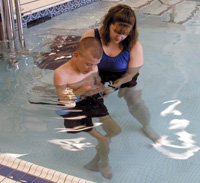The most standard form of treatment for spastic hemiplegia is physical therapy. There are many types of different treatments in this category that all are aimed at one goal, strengthening the muscles and preventing further stiffening of the muscles effected from this disease. Physical therapy would include sensory stimulation, stretching, strengthening and positioning. Constraint-Induced Movement therapy is a newer form of physical therapy for SHCP that involves casting or splinting the unaffected arm to promote use of the affected arm. The theory behind this method is that it would force new neural pathways to be created. Other forms useful forms therapy are yoga and dance. If therapy is implemented into a child’s life early on when the body is still developing it could potentially lessen the impact of impairment and minimize the child’s potential for developing associative conditions.
It is common for medication to be incorporated into the treatment as well. Medicines are used to help treat seizures, as well as other complications, that come about from this form of cerebral palsy. Spastic hemiplegia is not curable, but researchers are constantly looking for new forms of treatments and exercises to help prevent the occurrence of this disease.
One form of treatment is for a child with spastic hemiplegic cerebral palsy is neuromuscular electrical stimulation, also known as NMES. NMES can be used to improve gait or upper limb function by tibilalis anterior simulation and dynamic splinting(Durham,Ewins,Swain, & Wright,2011). NMES normally involves placing surface electrodes on the skin. To improve gaint, neuromuscular electrical stimulation can be applied during exercise to improve hamstring spasticity and lower limb function, and quadriceps-hamstring co-contraction. NMES should also be combined with task-specific and functional training. Stimulation to the gluteus medius bilaterally has been proven to result in an improvement in gait temporal spatial parameters and in hip abductor tone. Stimulation is applied during the gait cycle, but not during synchronized stepping. This treatment helps improve strength, range of motion, and function of the targeted areas. To improve upper limb function, NMES is used to assist with muscular strength and function. After treatment, patients may make functional improvements like increased awareness and spontaneous use of the impaired arm and hand, and an enhanced grasp and release ability(Durham, et al,2011). NMES can also be combined with orthoses to help gain muscle and function. Dynamic splinting, a form of orthotic intervention, occurs when a restorative force is applied by an orthosis, usually by means of a variable tension spring loaded hinge. It can be used to promote extension of the wrist and elbow joints. The application of neuro-muscular electrical stimulation, however, is cautiously advocated in helping improve gait. It is growing support much more rapidly to improve function and muscle in the upper limbs(Durham, et al,2011).
Aqua therapy (shown below) is gaining popularity for children with cerebral palsy because it has little impact on the body and increases exercise in children. Aqua Therapy is used to help promote muscle strength, aerobic capacity,gross motor function, and cardiovascular function. Most aquatic therapy studies involving children with neurological conditions describe effects of individualized aquatic interventions(Kelly & Darrah,2007). In a group setting however, games and other cooperative activities can be used to enhance a child’s interest in an exercise intervention. Current studies have had a time length varying from 6-10 weeks, doing pool activities 3-7 times a week. Children practice a repeated step-up motion, toe raises, and squat activities(Kelly & Darrah, 2007). The workout is obviously designed for the child’s condition and limitations. This study is based off of the dynamic systems theory of motor development by the acquisition of a motor skill as a dynamic and self-organizing process. It emphasizes the child’s role in the therapy and targets the environment, task, and child’s self(Kelly & Darrah, 2007).
Intramuscular injections of botulinum toxin type A(BTX-A) have increasingly been used to reduce spasticity in specific muscle groups in children with cerebral palsy. Targets of therapeutic efforts are improvement of gross motor function, alleviation of pain or facilitation of hygienic care (Kirschner & Berweck, 2013). Pes equinus is the most frequent clinical indication for treatment with BTX-A in children with cerebral palsy. One of the main therapeutic goals in such patients is to improve the gross motor function including facilitating walking as well as reducing the number of stumbles and falls. BTX-A injections significantly increased active elbow and thumb extension and significantly reduced tone at wrist and elbow (Kirschner & Berweck, 2013).
Recreation therapy is a treatment that helps children with cerebral palsy develop and expand physical and cognitive capabilities while participating in recreational activities. Recreation therapy is designed to allow children to participate in leisure activities by eliminating the roadblocks that block sports, arts, crafts, and games. Recreation therapy has many benefits for children with cerebral palsy – it can improve physical functionality, improve neurological connections associated with processing activities, and provide opportunities for inclusion. Physical benefits include improved coordination and increased strength and flexibility. It also improves behavior, confidence, and increases perception. Finally, some interventions that are used include cognitive training, wellness training, and behavior counseling.



